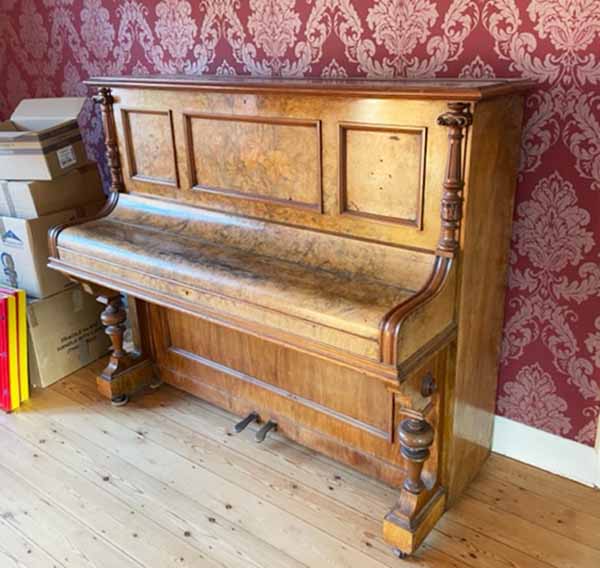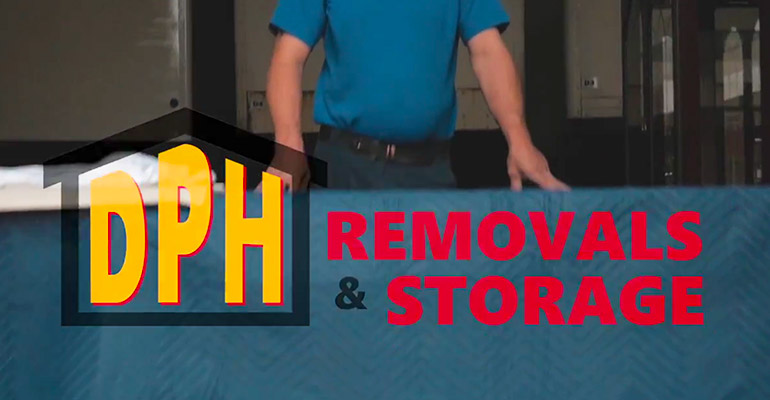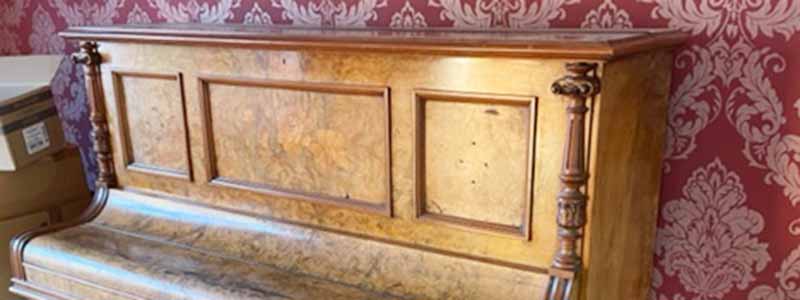DPH Removals Are Your Local Piano Movers
Mastering the piano is one of life’s greatest achievements. However, finding experienced piano movers can sometimes feel like quite the chore.
It can take years of study and countless hours of practice to play and/or craft melodies with the proficiency of Mozart. Similarly, getting the piano itself into your chosen location within your property, requires a lot of practice to perfect the skill. Skill that DPH Removals has in abundance.
For those of you lucky enough to have a piano, moving can be daunting. The piano must be transported safely, for a number of reasons:
- Pianos can be very large pieces of furniture
- Pianos can be physically bulky
- Pianos can be extremely heavy
- Pianos can be very expensive to repair or replace
- The value of a piano that has been in the family for years or generations, cannot be measured
- The finish of the outside of a piano needs protecting as much as its inner workings
Pianos are often among the most valuable things you are likely to own. Incorrect handling of them can be a recipe for disaster. Of course, moving a piano can be done successfully, but only if you use professional piano movers such as DPH Removals.
Feel free to contact us for piano removal advice.

Successful Piano Removals
When it comes to piano removals, there is no one-size-fits-all approach. There are so many different styles and sizes of pianos. Knowing which type you have is key to moving it without problems. The main varieties of piano are:
- Digital pianos: much like portable keyboards, digital pianos emulate the sound of the classic acoustic piano while avoiding the premier price tag. Where they differ from keyboards is that they have the full range of 88 keys, as opposed to 66. Additionally, many of the larger variants are designed to resemble the size of the acoustic instrument; meaning they can weigh up to 100lbs or 45kg.
- Console pianos: these are the most popular type of vertical piano. They usually stand 40 to 43 inches (1 to 1.5m) high and weigh from 350 to 450 lbs (150 to 180kgs). Thereby making them a lot heavier than digital versions.
- Upright pianos: moving an upright piano presents different challenges depending on the size. Uprights can weigh anything from 300 to 1000lbs (135 to 450kg). You should use professional piano removals, as it will take more than yourself and a friend or ‘man with a van’ to manoeuvre one.
- Grand pianos: this is the most iconic and expensive type of piano. They can weigh in excess of 1000lbs (450kg) for a concert grand piano. The purchase cost also likely to have been in the thousands. You really do not want to manhandle one of these!
Piano removals require a lot of careful preparation. DPH Removals have the expert knowledge to carry this out prior to moving, making it much easier to achieve a successful relocation of your prized piano.
The Benefits Of Using A Professional Piano Removal Company
Moving your piano without a professional piano removal company is certainly possible. However, it is worth considering whether this is something you really want to undertake by yourself. Whilst this article aims to explain all that is involved in moving a piano, there are definite benefits to enlisting professional help:
- Experience: DPH Removals have nearly 30 years of experience in removals in Lincolnshire, the UK and Europe. We have successfully moved many pianos in this time.
- Costs: you need to weigh up the difference between paying a for professional piano removal versus the cost of buying all the necessary equipment:
- Insurance: depending on the type of piano you have it should be included as an item within your contents insurance. For more expensive pianos, these may well be covered separately as high-value items. Either way, moving a piano yourself, exposes you to the risk of having to claim for:
- Damage to the piano itself
- Damage to the delicate inner mechanics of the piano
- Damage to flooring
- Damage to walls
- Damage to doorways
- Damage to other fixtures and fittings
- Damage to other items being moved at the same time.
Using DPH Removals as your professional piano removal company will mean that moving the piano is covered under our insurance. Therefore, in the unlikely event that something should go wrong, you are spared the potential cost of claiming on your own insurance. And as we all know, claiming on an insurance policy tends to push the price of future premiums up rather than down.

Why you should use a professional piano moving company:
If you are still considering not using a professional piano moving company like DPH Removals, and prefer to move a piano yourself, you should consider being prepared with the following:
- A piano dolly: this is an essential. A dolly is basically a small, wheeled cart that can take the weight of the piano on level surfaces, thus making it so much easier to move the piano without too much strain.
- Dolly straps: these will secure the piano onto the dolly and prevent it from slipping off when it moves.
- Plastic covers/blankets: wrapping a piano in some kind of covering is advisable for a few reasons:
- Wrappings will help keep any moving parts in place when the piano is being lifted or fastened onto the dolly
- Prevents any scuffs or cosmetic damage in transport
- Makes the piano less likely to damage anything around it as it is moved.
The ideal coverings can be:
- Strong plastic coverings;
- Household blankets
- Towels
- Other reasonably thick fabric sheeting
- Plastic stretch wrap
- Moving/packing/duct tape
- Lifting straps: a bit like a harness, you can use these to help take some of the weight on your shoulders, and protect your back, when lifting a piano. When shopping for these, make sure to check the recommended weight they can lift is suitable for your piano. Otherwise, they are in real danger of snapping.
- Transport straps: heavy duty straps that secure the piano during transit in a vehicle
- Piano shoes: these are cases that the piano sits in on its side. They look a bit like a sledge and are commonly used when moving a grand piano.
- Ramps: If you are moving the piano down a small number of steps, then you may be able to let a ramp do the majority of the work. Piano ramps are also useful when moving a piano onto a van.
- Gloves: a durable set of work gloves will prevent you from losing your grip when lifting a piano.
- Large vehicle: of course, most pianos will not fit in a normal vehicle and will require a van or small lorry, which for most people will need to be hired.
The list above, and the further tips below, will certainly make moving a piano easier. However, as there are many variants of pianos, you need to make sure that you check the piano’s specifications and only purchase/hire the equipment that is suitable for the size and weight of your piano.
We have to stress though that, using an experienced piano moving company like DPH Removals, will save you buying/hiring all of these items and most certainly end up costing less in the long run. In addition, the move will be done with great care, attention to detail and be fully insured. DPH Removals carry out this kind of work on a regular basis, so you can just sit back and let us do all the hard work for you.
What Is The Typical Piano Moving Cost?
Estimating the typical piano moving cost is not advisable without seeing the piano itself, the room it is in and how to exit the piano from the property.
All of these factors will determine the actual piano moving cost. Typically, we would price the move based on the following factors:
- Type of piano to be moved
- Location of the piano in the property
- Doorways, hallways and any other exit points
- Access of the piano to our removal vehicle. For instance, how close we can get to the property and distance to carry to piano to our vehicle
- Any possible obstructions along the route that may need to be temporarily removed
If you have been quoted for moving a piano without anyone considering the above, then chances are that they may have not moved a piano before. Most importantly though is to make sure the people moving the piano are fully insured. Damage to the piano or property during the removals process can prove incredibly costly to you if they are not!
Here Are Some Tips To Consider When Moving A Piano
- Measure, measure, measure
Do not attempt to move anything until you know what you are working with. Measure the piano against the size of your corridors, doorways and staircases. That way you will know if any other work needs to be carried out beforehand, such as removing any doors to accommodate the piano. Also, be sure to remove any other obstructions along your route so you have the maximum space to play with. There is nothing worse than lifting something very heavy only to find that it will not fit through a doorway, or there are obstacles in the way!
- Protect floors and surfaces
Owing to their value, it is natural to be worried about potential damage to your piano itself. However, you also need to consider the surfaces that a piano dolly for instance will be moving over. Laying down some kind of frictionless covering is always a good idea to avoid scratches, scuffs and marks.
- How to lift a piano
All parts of the piano should be wrapped securely with tape to ensure that nothing moves or falls. Any removable parts like the feet and legs should be removed and wrapped separately to make transporting the piano more manageable. Once this has been done, the piano should be lifted gently on its side onto a dolly that is an appropriate size for your instrument i.e.at least half the length of it. Whilst lifting straps can make this process a lot easier, there are no shortcuts when it comes to staircases; a dolly will not be any use up or down flights of stairs, so there is no alternative to carrying it manually. Take it slow and communicate clearly with those helping you.
- Moving an upright piano
Upright pianos require a lot of care with the lid and pedals when moving. Ensure the lid is secured and will not come open when moved. This can be done with blankets and moving tape. Once this is done, use plastic stretch wrap around the pedals to stop unwanted motion and provide protection against superficial damage.
Upright pianos are a bit more forgiving to move than grand pianos, and smaller ones can be managed by two people lifting at either side, with straps etc.
- Moving a grand piano
Although bulkier and heavier than upright pianos, the process of moving a grand piano is not that dissimilar to moving other types of piano. What you need to be especially aware of in this case is the large lid on top of it. Dedicate a lot of time to securing this, and then use a screwdriver to remove legs and feet. Make sure someone is on hand to lift the side of the piano when removing these, to prevent the piano from falling and being damaged.


